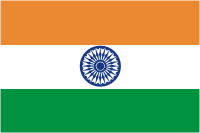
I really like Rajasthan. It is in the west of India bordering Pakistan and is largely dominated by the arid and rocky landscape of the Great Thar Desert. Seeing a camel in Rajasthan is about as common as seeing a Ford in the US, which of course makes it really exotic for someone like me. The men traditionaly grow absolutely huge mustaches (this is a traditional sign of age status, perhaps) and sometimes curl them at the ends, although we really didn't see much of it. They are also adorned with oftentimes colorful turbans to keep cool. This is different from the Sikhs who wear turbans as religious requirements to cover the hair at all times (I have Sikh students in my classes in Andhra Pradesh).
Insterestingly, Rajasthan seems like one of the few places where the men can sometimes be more colorful in their dress. All over India it seems like women, regardless of status, wear the most exquisite saris and salwar kameez in a dizzying array of colors. There is something absolutely stunning about the way the sari functions so efficiently - I have seen women adjust it to cover the head during hot sun or light rain, completely cover their heads and faces when street pollution is high, or just the way the extra fabrics flow in the breeze to create a fantastic visual effect.
Interestingly the students in my school are more often from the north of India than the south. When I asked my mentor teacher, Mr. G.S. Reddy about this, he quickly responded that the north has historically often been invaded from Persia, China, etc. and therefore has required large warrior castes. The south, insulated on three sides by the oceans and by large distances along the Deccan peninsula from northern states has had less of a need for these castes. The Rajputs from Rajasthan are no exception and are proud of their long history of not being conquered by the Persian invaders from present day Afghanistan and Iran. Apparently, when faced with certain defeat in battle, Rajput warriors donned saffron robes and rode to certain death into the face of the enemy while the women and children would throw themselves into funeral pyres to avoid the shame of capture. This form of mass suicide was called jauhar.
Also from Rajasthan are many Jains - an interesting group which vows a respect for all life - including insects, worms, etc. This prevents them from eating certain foods, like tubers, which can kill insects when uprooted.
We arrived in Jaipur, the royal city of Maharajas, and capitol of Rajasthan, by eveningtime. We decided to splurge on an insanely swanky hotel outside of the city in a hill village called Samode. The hotel was formerly the residence of the Prime Minister of Rajasthan and was nothing short of the most luxurious hotel I have ever stayed in (Conde Naste nice). Jaipur is a city of contrasts - made rich in the past from the semi-precious jewel trade and jewelry markets - but it has also been tapped by the extravegant lifestyles of the royal families. Rajasthan itself, especially the countryside near Samode, was very poor. Indian educational statistics put literacy rates at about 60% - a massive improvement from just 8% when India gained independance in 1947.

Our Rajasthan experience began in earnest on the 14th, when we took an elephant ride up the ramparts of the Amer Fort - the once hilltop fortress palace of the Maharaja. We then spent the day visiting a 15th-century Hindu Temple and the Royal Palace and celestial observatory of the Maharaja Jai Singh. The observatory was of course a highlight given the precision with which one was able to tell time and date from taking measurements from the sky. One of the sundials was accurate to within 5 seconds.

 Our Rajasthan experience began in earnest on the 14th, when we took an elephant ride up the ramparts of the Amer Fort - the once hilltop fortress palace of the Maharaja. We then spent the day visiting a 15th-century Hindu Temple and the Royal Palace and celestial observatory of the Maharaja Jai Singh. The observatory was of course a highlight given the precision with which one was able to tell time and date from taking measurements from the sky. One of the sundials was accurate to within 5 seconds.
Our Rajasthan experience began in earnest on the 14th, when we took an elephant ride up the ramparts of the Amer Fort - the once hilltop fortress palace of the Maharaja. We then spent the day visiting a 15th-century Hindu Temple and the Royal Palace and celestial observatory of the Maharaja Jai Singh. The observatory was of course a highlight given the precision with which one was able to tell time and date from taking measurements from the sky. One of the sundials was accurate to within 5 seconds.



No comments:
Post a Comment